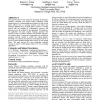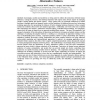1104 search results - page 21 / 221 » Understanding Human Behavior Using a Language Modeling Appro... |
IUI
2003
ACM
14 years 1 months ago
2003
ACM
This paper describes lessons learned in developing the linguistic, cognitive, emotional, and gestural models underlying virtual human behavior in a training application designed t...
UM
2009
Springer
14 years 2 months ago
2009
Springer
Abstract. Recent sensor technologies have enabled the capture of users’ behavior data. Given the large amount of data currently available from sensor-equipped environments, it is...
ENVSOFT
2007
13 years 7 months ago
2007
: Increasingly, models (and modelers) are being asked to address the interactions between human influences, ecological processes, and landscape dynamics that impact many diverse as...
POPL
2007
ACM
14 years 8 months ago
2007
ACM
We describe a framework for better understanding scheduling policies for fine-grained parallel computations and their effect on space usage. We define a profiling semantics that c...
ICRA
2002
IEEE
14 years 25 days ago
2002
IEEE
Dynamical systems theory is used here as a theoretical language and tool to design a distributed control archictecture that generates navigation in formation, integrated with obst...


